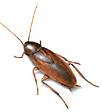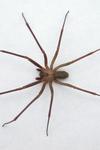 | ||||||
Pest Services
__________
Cockroaches are one of the most hated insects, especially when they are found inside homes. There are several different kinds of cockroaches including:
German - Found throughout the world; commonly found in restaurants, kitchens and stores where food and moisture are
abundant contaminate food, leave stains, create foul odors and carry disease organisms.
Smokybrown - (Commonly mistaken for waterbugs) Typically brownish black and very shiny. They fly and are attracted to
lights at night; has the reputation of being the most difficult to control because it is so active and has many habitat
preferences.
Oriental - Also known as black beetles; more sluggish than other species; give off distinctive unpleasant odor.
American - Also mistaken for a water bug, the largest house-infesting species, about one and one-half inches
long; reddish-brown wings with light markings on thorax.
Brown Banded - Easily recognized by alternating light and dark bands across its back; doesn't multiply as fast as the German,
but it considered harder to control; often found high on walls in picture frames, behind molding, near appliance motors,
in light switches, closets and furniture.
__________
Fleas are small, hard-bodied wingless insects with a flattened body and legs adapted for jumping on to a host. Humans are often attacked when other food sources aren't available. Their bite leaves a red, itchy spot on the skin. Their saliva is irritating to the host, causing dermatitis and hair loss in allergic animals.
Control begins with treatment to all infested areas with a residual pesticide that includes a growth regulator inside the home and a complete lawn treatment outside. Generally, lawn treatments done early enough in the season are enough as long as control continues on the inside of the home. The pet should be treated regularly either with powders, sprays or a treatment recommended by your vet. While "dips" are effective for overall treatment at once, maintaining a constant control on the pet is best. Pick up all items off the floor. Remove items from under beds and furniture and the bottom of closets. Wash or replace pet bedding. Vacuum thoroughly throughout the house. Wood, tile and linoleum floors should be thoroughly swept and mopped. Concrete floors in a garage or basement, where pets may stay, need to be cleaned. Remove all pets including birds. Fish tanks should be covered with a damp towel and the air pump turned off and covered. Treat pets Shampoo, then use drops, dogs only. Remain out of the house for at least three hours. Outdoors, wash or remove any pet bedding and make all shade areas, crawl spaces, etc., available for treatment.
__________
Ants
Carpenter Ants - Usually nest outdoors in stumps and logs in contact with the soil and in dead tree limbs and
cavities or in homes in wood damaged by termites, fungi and moisture. They don't actually eat wood - though
the galleries they excavate can be quite extensive.
Pharaoh - Small red to yellowish ants that can nest in wall voids, cabinets, boxes of food and any other accessible
crevices and spaces and are even known to invade sick rooms and feed on blood plasma and wound dressings.
Thief Ants - Tiny ants that sometimes go undetected for weeks. They earn their title by feeding off the larvae of
other ant species. Commonly seen around the kitchen sink or pantry, they go for cheeses, greasy foods, meats
and sometimes sweets.
Argentine Ants - Among the many species who like honey, syrups and jellies, they are also meat eaters and outside
they can severely damage orchard crops.
Red Imported Fire Ant - Usually a reddish brown color, fire ants live in colonies of up to 200,000 individuals with mounds
that can be two feet high and three feet across with as many as 50 colonies per acre. It's painful, burning sting results
in pustules that take up to 10 days to heal. Some people are extremely allergic to the sting, needing fast medical attention
to deal with the toxin. It usually takes ants years just to get firmly established. But once that's accomplished, some
colonies can survive for as long as 30 or 40 years. Sometimes the original queen will be replaced many times over.
There are measures you can take to minimize the likelihood of an ant invasion in the kitchen; wiping up spills and putting food away immediately in sealed containers helps. Keeping your home dry and well ventilated will discourage dreaded Carpenter Ants from entering. When ants do get in, insecticides applied along baseboards or around foundations can provide some temporary relief. But ants seldom carry enough insecticide back to the nest to kill the queen... so the nest must be located and the colony destroyed. The professionals at All American Pest Control know where to look and how to fight with the best products available on the market.
__________
Rats And Mice
Rats and mice are the most abundant and therefore the more annoying and destructive of all rodents the homeowner or business owner may encounter. Throughout history, they have been responsible for more human illnesses and deaths than any other mammals. The most common are the Norway Rat, the Roof Rat and the House Mouse.
Controlling rodent infestations is mostly due to the common sense elimination of their food, water and harboring sources. Elimination of whatever possible that makes them happy is always the first step and should be addressed at the first signs of their presence. Beyond that, baiting and/or trapping would be next. Baiting is the first choice as it is effective in most cases and is the simplest solution. Trapping requires much maintenance and constant monitoring and of course, disposal of the trapped rodents.
__________
Spiders
Black Widow Spider
Glossy black with a red hourglass marking on the underside of its abdomen, it makes a strong, sticky irregular web in protected areas where prey is likely to wander in and be trapped. Foundations, vents, shrubs and woodpiles at ground level are common habitats.
Their highly poisonous venom can cause concern for small children and older or infirm persons. Medical attention should be
sought if bitten. Some trap their prey in webs or snares; others are active hunters that use excellent vision to stalk or
ambush their food. Virtually all spiders have poison glands that connect with the fangs. Venom produced by the glands apparently
is used to kill or paralyze prey and in defense. Only a few species, such as the black widow and the brown recluse, have venom that is very toxic or harmful to humans.
Brown Recluse Spider
A brownish spider with distinguishing characteristics of the presence of three pairs of eyes arranged in a semicircle on the
forepart of the head and a violin-shaped, dark marking immediately behind the semicircle of eyes with the neck of the violin
pointing towards the bulbous abdomen. This violin-shaped marking has earned it the name "fiddle-backed" spider.
It is found in undisturbed areas such as sheds, garages and dark closets. Garments left hanging for some time are favorite
spots. The brown recluse spider is not aggressive and normally bites only when crushed, handled or disturbed.
Their bite causes a severe systemic reaction and an ulcerous sore, which requires extensive medical attention. Fatalities are
rare, but bites are most dangerous to children, elderly and those in poor physical condition.
Most species do not attempt to bite; many have fangs that are not capable of piercing the skin. However, some will, with results that are similar to a wasp or bee sting. There is the chance that a person can have an allergic reaction to the venom.
First Aid if bitten: remain calm, collect the spider, if possible, for positive identification and get medical attention immediately (contact your physician, hospital and/or Poison Information Center & apply antiseptic solution to prevent infection and ice packs to relieve local swelling and pain directly to the bite area.)
Steps to prevent encounters with spiders:
Shake out clothing and shoes before dressing, and inspect bedding and towels before using.
Do not go barefoot or handle firewood without gloves.
Remove piles of trash; eliminate cluttered areas in basements, closets, attics and other outbuildings.
Dust and vacuum thoroughly and more in normally undisturbed places.
"Call today for your free inspection!"
We provide a wide range of services to keep your home or business pest free including, but not limited to:
Residential and Commerical Pest Control- The following are just a few of the occasional invaders that look for a new place to hide in your home. Don't let it happen to you! These pests can carry bacteria and disease and are a health hazard as well as being unsettling. Targeted treatments, including baits, traps, and sprays eliminate your problems, and improve your peace of mind. Let us solve your pest problem today!
Schedule Your Service
Call now to speak with a live representative
252-726-8899 Morehead City
252-504-3200 Beaufort
910-455-2847 Jacksonville
252-634-2847 New Bern
or click here to submit a request form and we will contact you.
All American Pest Control











